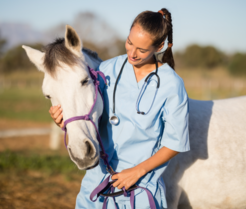
Veterinary Services Shortage Situations
Fiscal Year 2019 Shortage Situations for the Veterinary Medicine Loan Repayment Program (VMLRP) are available on the NIFA website. VMLRP received feedback in previous years that simultaneously posting both the Shortages and the Request for Applications (RFA) left some applicants without adequate time to consider the many factors of a given shortage prior to submitting an application. Posting the shortages in advance of this year's RFA eases the burden on applicants. Though the lapse in appropriations at the beginning of the year impeded progress, releasing the RFA is now a top priority. Email questions to vmlrp.applications@nifa.usda.gov.
Female veterinarian with horse, image courtesy of Getty Images.
|

A New Opportunity in Soil Science Research and Engineering
Soils are complex living ecosystems that form the foundation of all terrestrial ecosystem services, mediating a myriad of biological, chemical, and physical processes that interact to cycle carbon and nutrients essential for plant growth, food and fiber production, and to remove contaminants from water and air. They are the key to both plant and animal production systems and to maintaining environmental, agricultural, and forest sustainability. Soils support food production, economic prosperity, and many more services essential for humanity, including supplying organisms that produce antibiotics, controlling the movement of water, and acting as a source and storage media for gases important to life, such as oxygen, carbon dioxide, and methane. It is important to understand, predict, and sometimes modify soil properties and processes, even while it is not easy to see what is going on underground. NIFA’s Agriculture and Food Research Initiative, is partnering with the National Science Foundation and four research councils within the United Kingdom Research and Innovation. This program fosters collaboration among partner agencies and the researchers they support by combining resources and funding for the most innovative and high-impact projects. Learn more about the Signals in the Soil (SitS) program solicitation.
Soil image, courtesy of USDA.
|

4-H Students Gear Up for Robotics Competition
It’s that time of year again, when 4-H'ers get excited about robotics and prepare to compete as seen in a previous year’s competition. Prairie View A&M University’s Cooperative Extension 4-H and Youth Development program focuses on cultivating skills in youth to develop them not only educationally, but physically, socially, and otherwise. One of the ways they promote learning is through hands-on projects for the students and socializing them with peers from all over. Through the 4-H Agribotics program, 4-H'ers learn about innovation and technology while having a good time learning employable skills. Read the full Prairie View A&M University story.
4-H students, image courtesy of Prairie View A&M University.
|

Workshops Offer Tools for Farm Transfer Planning
Clemson University Cooperative Extension is partnering with South Carolina Farm Bureau to guide South Carolina farmers through what can be an intimidating process: developing and implementing a transition/succession plan for their farms and timberland property. NIFA supports the program with a grant through the Southern Extension Risk Management Education Center. Clemson Extension will hold a series of Farm Transfer Workshops across the state. Read the full Clemson University Newsstand story.
|
1890 Institution Teaching, Research, and Extension Capacity Building Grants (CBG) Program
The 1890 CBG program strengthens teaching, research, and extension programs in the food and agricultural sciences by building the institutional capacities of the 1890 land-grant institutions, including Tuskegee University, West Virginia State University, and Central State University. CBG supports projects that strengthen teaching programs in the food and agricultural sciences through curriculum design and materials development, faculty development, extension program development support systems, and others. This initiative will increase and strengthen food and agriculture sciences at the 1890s by integrating education, research, and extension. CBG applications must address at least one of the following NIFA strategic goals: sustainable bioenergy, food security, childhood obesity prevention, or food safety. See 1890 CBG program for more details.
Cyber-Physical Systems (Joint NSF) Competitive Grants Program
Cyber-physical systems (CPS) are engineered systems that are built from, and depend upon, the seamless integration of computational algorithms and physical components. Advances in CPS will enable capability, adaptability, scalability, resiliency, safety, security, reliability, and usability that will far exceed the simple embedded systems of today. CPS technology will transform the way people interact with engineered systems. New smart CPS will drive innovation and competition in sectors such as agriculture, energy, transportation, building design and automation, healthcare, and manufacturing. Despite significant recent inroads into CPS technology, there is not a mature science to support systems engineering of high-confidence CPS. In 2019, National Science Foundation is working with NIFA to identify basic research needs in CPS common across multiple application domains, along with opportunities for accelerated transition to practice. Learn more about the CPS competitive grants program.
Secondary Education, Two-Year Postsecondary Education, and Agriculture in the K-12 Classroom Challenge Grants Program (SPECA)
SPECA promotes and strengthens secondary education and two-year postsecondary education in the food, agriculture, natural resources, and human (FANH) sciences to help ensure a workforce that's qualified to serve the FANH sciences system. The program promotes linkages among secondary, two-year postsecondary, and higher education programs to advance excellence in education and encourage more young Americans to pursue and complete baccalaureate or higher degree in FANH sciences. More details about SPECA grants program.
|